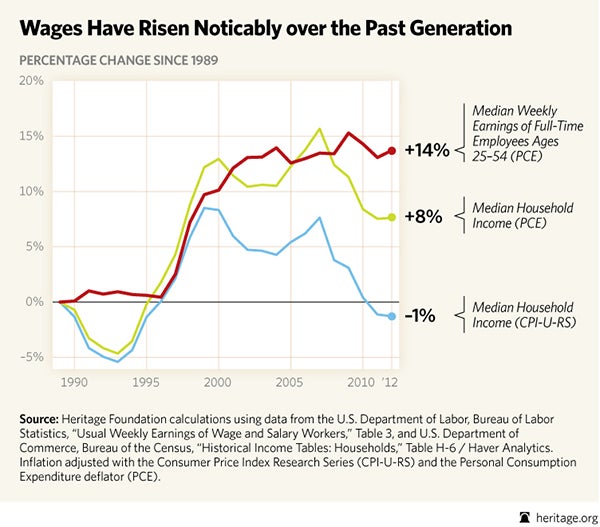The Typical Worker Earns More Today Than in 1989
James Sherk /
Do American workers have lower living standards today than in 1989? To anyone with a camera GPS library stereo video recorder TV smartphone in his or her pocket, it doesn’t look like it. But the Census Bureau recently released a report finding real median household incomes lower today than 24 years ago. Have incomes really stagnated over the past generation?
No.
The Census report has several caveats. For instance, it uses a less accurate measure of inflation and includes households with no workers. These caveats drive the conclusion. A more accurate approach would find the median worker making one-seventh more than in the late 1980s.
The Census adjusted for inflation using the Consumer Price Index (CPI). However, economists have concluded that the CPI overstates inflation. Among other problems, it adjusts to changing consumer behavior slowly (such as Americans buying more smartphones as they become less expensive) and understates the value of technological improvements.
For this reason, both the Federal Reserve and the Congressional Budget Office rely on an alternative measure of inflation: the Personal Consumption Expenditures (PCE) index. The PCE partially accounts for problems with the CPI and generally finds inflation running about half a percentage point lower than the CPI does. In the short term, this makes little difference; in the long term, it adds up.
Further, the Census Bureau looked at the median household, not the median worker. Labor force participation has fallen sharply since 2007—mostly because of the economy but also partly due to baby boomers retiring. Fewer adults work or look for work now than at any time since 1978. This automatically reduces household income, even if wages do not change.
This figure shows how much of a difference these assumptions make. It shows the change in median household incomes since 1989—adjusted for inflation with the CPI and the PCE. It also shows the change in median weekly earnings for full-time workers ages 25–54, adjusted for inflation with the PCE. Using the PCE finds the median household making 8 percent more than in 1989. Looking at median wages shows earnings rising by 14 percent. Living standards have notably improved over the past generation.
That does not change the pain Americans have gone through in the recession and its non-recovery. Millions of Americans remain unemployed or have given up on finding work altogether. But Americans with jobs are better off today than they would have been 24 years ago.


